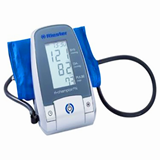http://www.pstm.net/index.php" target="_blank">Public Sector Technology & Management
The illegibility of doctors’ written notes is proverbial, and is a symptom of a working environment that is both information-intensive and highly mobile. Quickly-scribbled notes from a bedside consultation have to be integrated with a range of more remotely stored data relating to medical records, digital imagery, as well as the supply chain and financial applications that are fundamental to the efficient running of any hospital.
mWard
MMC is at the cutting edge of wireless technology in the region: it is the first Australian healthcare site to run a converged data and voice infrastructure securely using a switched wireless network. The project, called mWard, has been developed by the Centre for Health Services and Operations Management (CHSOM) at Monash University, also in Melbourne.
"This represents a huge change in the healthcare industry, where patient information usually consists of handwritten notes and hard copy reports stored in different places,” says Dr Liza Heslop, Director for CHSOM. “By making a more comprehensive array of information more readily accessible where it is most needed, we can improve patients' hospital experiences dramatically."
The project's chief aim is to speed up the flow of patient information, and increase accuracy, eliminating the errors and double handling that can occur when hard copies of information are misplaced or take too long to locate. By giving doctors, nurses and other caregivers access to correct, up-to-the-minute information wirelessly, hospitals can work more efficiently and reduce potential mistakes such as administering the wrong treatment to patients.
“Mobility will benefit the clinical team in many areas especially in relation to pathology results and radiological investigation images as well as real-time information that the staff can rely on,” explains Nurse David Ramsay, Stroke Specialist at MMC. “These include better time management, greater efficiency and the ability to involve patients in the decision-making process.”
The trial uses NEC tablet PCs that receive and display the larger reports, such as X-Rays, alongside Symbol Technologies wireless handheld devices that enable doctors and nurses to obtain pathology and patient history reports at the patient's bedside.
The potential number of staff using the system once it is fully operational includes all three of MMC’s clinical medical teams - Neurosurgery, Neurology and Stroke - which are made up of around 20 doctors, along with a further 50 nurses and 12 therapists.
"Health workers spend a significant amount of time and effort seeking information to make the next key decision about a patient's treatment. We believe this technology will allow the hospital to run more efficiently, enabling us to treat more patients,” adds Dr Heslop. “Instead of spending hours waiting to access information, hospital staff will be able to treat and discharge patients quickly and accurately.”
Mobilising patient data
When patients are admitted to Monash Medical Centre's 26-bed neurology ward, where the mWard project is taking place, doctors and nurses receive information, such as pathology results and X-Rays to the handheld device through a wireless network. This facilitates decision-making at the patient's bedside, and reduces the amount of time it takes to make and act on decisions about patient care.
The wireless switched network supports multiple virtual Wireless Local Area Networks (WLANs), each of which can be used for a different purpose, such as voice and data applications. This means that the quality of service for each application can be maintained, which is essential for an organization like Monash Medical Centre. Traditional wireless networks don't support multiple virtual WLANs, so performance can suffer.
Because the switched wireless network supports all applications on one infrastructure, there is more flexibility to use converged devices. This means lower costs for the organization and a simplified work environment for doctors and nurses who now only have to carry one converged device rather than a PDA, wireless phone and pager.
“As with any organization, there is a mixed reaction to the new equipment as the staff consists of those who are keen to use new technology and those who are techno phobic,” says Ramsay. “But seeing how user friendly the new equipment is, several other departments are already keen to be involved in the project as a second trial site. Our management are monitoring the results of the trial implementation carefully to decide a further course of action.”















